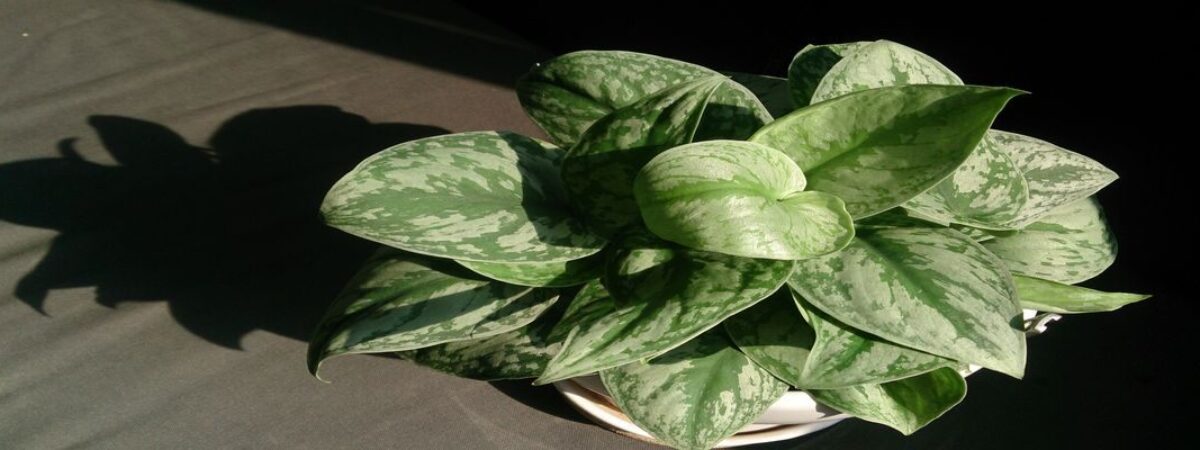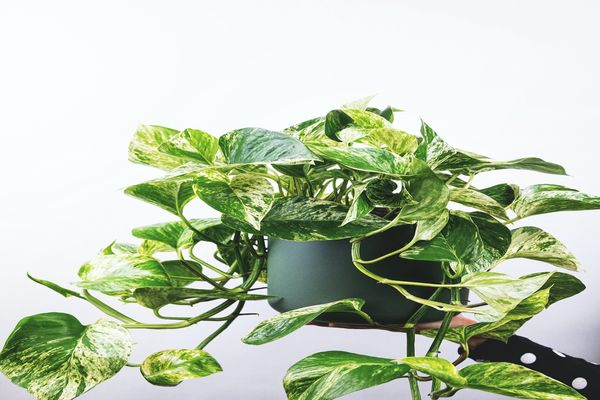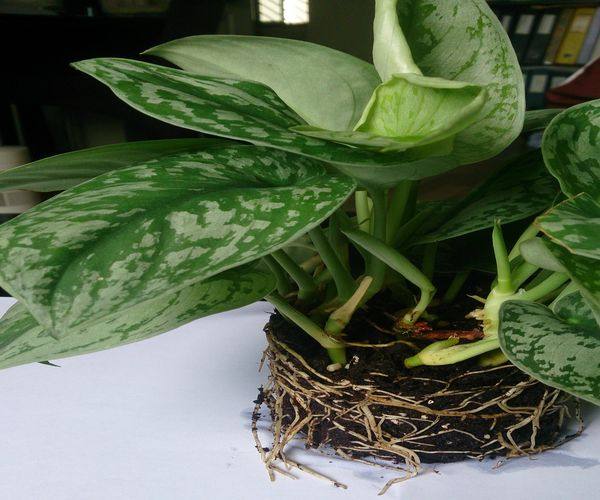Do you want to brighten up your home or garden with some air-purifying greenery, but you’re afraid that you don’t have a green thumb?
No worries. Silver Pothos is the plant for you!
They are beginner-friendly, easy to grow, low-maintenance plants that reward you with beautiful foliage for little effort. So with a few simple care tips, you can have gorgeous Silver Pothos weaving through your living space and offices in no time.
So let’s dive into the article below to find more about silver pothos to cultivate.
Plant Overview
With cascading heart-shaped beautiful silvery leaves that have a soft satin-like texture, beautiful marbling, and hardy nature the Silver Pothos is a stunning houseplant that stands out amongst the rest.
The Silver Pothos and also named the Satin Pothos, or Scindapsus pictus is a very popular houseplant that is just as easy to grow as its pothos cousins.
This dazzling unique beauty has a deep greenish-blue hue that is sparkled and splotched with silver-grey variegations. However, no two leaves are same.
Silver pothos or satin pothos is a variety of the species Scindapsus pictus. These beautiful evergreen houseplants are members of the Arum plant family.
Popular for its unique grey-to-silver variegation on the blue-green leaf surface, this tropical vine grows slower than other pothos varieties because of its less chlorophyll content in the leaves. But still, it is very easy to care for and willingly grows lush hanging baskets or long winding vines when given a trellis.
Being originated from India, Bangladesh, Thailand, Java, and the Philippines, it can climb up to 10 feet tall or more with vining vigorously along the rainforest floor in its native place. however, these plants remain in the juvenile stage and attain the height of 1 foot when grown as a houseplant.
The alternating leaf pattern of zig-zag arrangement and silver speckling make the silver pothos very recognizable as it winds their way up rainforest trees.
Caring guide for silver pothos
Being a low-maintenance plant, silver pothos doesn’t require any caring at all. So It doesn’t require anything special and is pretty hands-off. however, providing a little care to the plant can shower you with abundant growth and beautiful foliage.
The caring guide of this beautiful vine is given below,
Light
Satin pothos plants require plenty of bright, indirect sunlight to thrive. So if you are planting it as a house plant in a pot, the best location for this is in near an east- or west-facing window where it can get some morning or evening sun. But, avoid placing these silver leaf pothos in direct sunlight, otherwise, it can scorch them.
Place your plant pot in a bright location where it can filter sunlight. But avoid placing it on a deck, patio, or windowsill where it is in direct sunlight all day long.
Although it requires plenty of light, it also can grow in low-light conditions. However, the vines of the plant become sparse and leggy and look unkempt. The lack of adequate light may also cause the silver variegation of the plant to lose its vibrancy. So If you are noticing that the leaves of your silver pothos become darker, move it to a brighter location to encourage faster growth.
Temperature
Being a tropical plant, the minimum temperature to grow silver pothos houseplants is 60°F (15°C). So, if you are growing pothos plants outdoors, you can keep it outside as long as it is sunny and the temperature is above 65°F (18°C).
If it gets too cold that the temperature falls below 50°F, these fragile heat-loving plants will start to wither and probably die, so never keep your silver pothos in an uninsulated room. It’s also recommended to keep your plant away from window drafts or cold air from doors.
Soil
Satin pothos thrives well in a rich, well-draining potting mix. The best type of potting medium to grow this vine should have organic matter it to hold moisture. However, it should be light enough so that water can drain freely. The growth of the plant will slow down if it grows in soggy, waterlogged soil.
If you want to grow a potting mix for your silver pothos, you should mix equal parts of potting soil, peat moss, and perlite. Instead of perlite, you can also add charcoal pieces or coco coir chips to help increase water drainage. The peat moss in the soil will keep the soil moist so that the roots get nourished.
Water
The silver pothos requires watering at regular interval. The most common mistake people do while growing pothos is overwatering and underwatering.
If you want to get the perfect sweet spot of water for this gorgeous tropical vine, imagine the wild conditions it would usually grow in.
So it is suggested to water your silver pothos as often as the top part of the soil dries out. In summer, your plant may require watering as often as twice a week or more. In winter, the silver pothos requires less frequent watering. The goal of watering must be that the roots are always slightly moist.
Besides you can check your plant frequently whether it needs watering or not. To check when your pothos plants need watering, firmly press on the potting soil to check for moisture. If there is a hint of dampness, leave it for a few days until the top part of the soil dries completely.
Apart from that, you can also check the drainage holes of the pot. The soil at that end should be slightly damp. The best advice for watering your pothos is to check that the top 2” (5 cm) of soil dry out completely.. Then give your plant a thorough watering.
Fertilizer
Being pothos are used to growing on the crowded rainforest floor in fairly leached soils, they do not need much fertilizer in general. However, if you want to give your plant a little extra boost during the growing season, you can use a diluted fish and seaweed fertilizer solution to provide some extra nutrients and promote new growth.
But make sure to dilute your fertilizer thoroughly otherwise you may end up with a fertilizer-burned plant.
Feed your plant once a month during the growing season. Stop feeding it during the winter months and then restart in spring when growth becomes vigorous. It is also suggested not to overfertilize your plant as too much fertilizer can be just as bad as starving it of nutrients.
How to propagate the silver pothos plant?
Being the plant takes a lot of time to mature, propagation is generally not done through stem cutting. Propagation of silver pothos can be done effectively through stem cutting. Cuttings are simply the pieces of a healthy stem that are cut and placed in water to grow new roots.
The following are the steps to propagate your plant
- Find a long healthy vine of silver pothos from your mother plant and count back 3-4 leaves from the tip of the vine. Find the nodes by the fourth leaf.
- Make a clean cut at a 45° angle with sharp scissors, pruners, or a knife, and remove the lower 1-2 leaves.
- place the cutting in a jar of water. Keep the two leaves of the plant above the water to photosynthesize while the baby plant develops new roots. Keep both nodes under the water surface.
- Place the jar near a window where it can get bright indirect light and stay warm.
- After a few weeks, you can begin to see white root hairs emerging from the bottom of the cutting.
- Once these roots become a bit more robust usually after 1-2 months, transplant the cutting into a well-drained potting mix and grow alongside your other pothos.
Common pests
spider mites, mealybugs, thrips, and fungus gnats are all the little annoying bugs that can colonize your plant, and cause problems. They start growing on the plant as a sign of overwatering or stagnant conditions without enough airflow.
As soon as you notice signs of these pests on your, act quickly. Rather than causing your silver pothos to die, these pests can infest nearby plants in your home. So to deal with these plant pests, simply use a diluted neem solution or horticultural oil on a soft towel and wipe down the leaf surface.
Conclusion
As you read this article this far, you might have gotten the knowledge of its growing and caring guide. Now you can take up the decision whether you should bring it home or not.
This plant is a gorgeous tropical vine with air purifying qualities that can make an excellent addition to any indoor gardening space and looks very unique compared to other plants. So bring this exotic plant to your home and have its benefits.
You may also like to read
Snake Plant Propagation – 4 Methods of Propagating the Attractive Houseplant!










